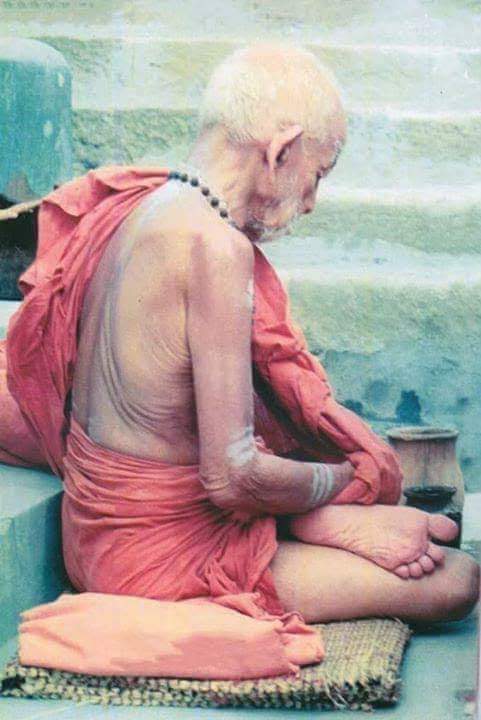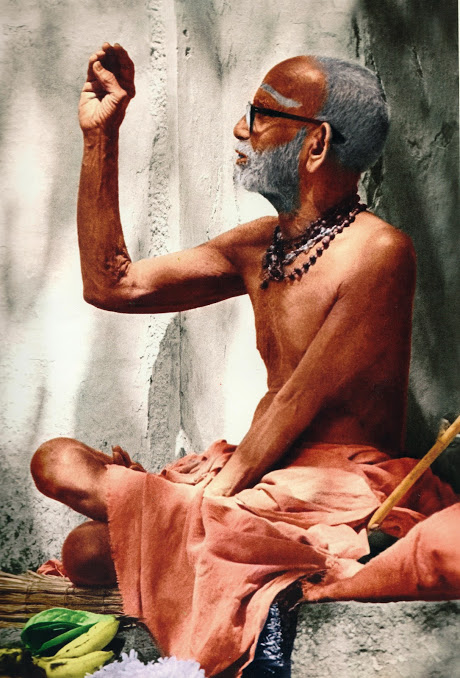
The speech delivered by His Holiness Jagadguru Sri Sankaracharya of Kanchi Kamakoti Peetam at the Tiruppavai-Tiruvembavai Conference held at Kancheepuram on Sunday, January 31, 1960.
"Forty or fifty years ago, it was difficult to find even a single Nattukottai Chettiar without
"Forty or fifty years ago, it was difficult to find even a single Nattukottai Chettiar without

smearing sacred ashes and without wearing a rudraksham around his neck. For that Sri Sundaraswamy, who was living on the banks of the Tambraparani, was responsible. He was a great devotee of Siva and had gained spirituality by his religious observance. There was none to equal
him in devotion and performing sacred services. He was responsible for the Kumbhabhishekam of seven temples in Tiruvarur on a single day. Several Gujaratis who had settled down in the Sowcarpet area of Madras were his disciples and they also used to wear Rudraksha round their
neck. This Swami has his Samadhi at Chettinad. The seed of devotion to Siva sown by him grew into a tree and bore fruit. About 50 years ago, there lived in Koiloor in Chettinad, another equally great Swami, known as Veerappa Swamigal. He was also a person of great devotion and
purity of life. But he was subject to fits of anger. If he cursed any person in his anger, it had disastrous effect. So the Nattukottai Chettiars dreaded him. If he directed any person to do a particular service, like renovation of a temple or the starting of a Veda Patasala or
the endowment of a choultry, that person implicitly carried out the direction. In that way, through the instrumentality of Veerappa Swami, several temples were renovated, several patasalas started and several choultries founded. The seed of devotional service implanted by Sri
Sundaraswamy grew and flourished because of the influence of Veerappa Swamigal. As I said, this Veerappa Swamigal had one drawback and that was his susceptibility to temper. We pray God that we should have no enemies. But what greater enemy can a person have than anger? Veerappa
Swamigal was greatly worried over this drawback and was wondering how he could overcome this internal enemy, temper. Now, this Veerappa Swamigal had a Brahmin companion named Subbaraya Iyer. This Brahmin used to read out to Veerappa Swamigal the Puranas, Nyaya Sastra and other
works. Veerappa Swamigal asked this Brahmin whether he had come across in any of the Puranas or temple legends (Sthala Purana) a method to get rid of anger. This Brahmin said that he was acquainted with several Sthala Puranas and there was one particular legend which may be
applicable to the Swami. Now, it is a pity that there is a tendency to dub Sthala Puranas as fiction, invented to exaggerate the importance of each temple. Even some Asthikas (religiously minded persons), fall for this kind of argument and regard these Sthala Puranas as having no
particular significance. But the fact is that these Sthala Puranas contain a fund of information and supply many a missing link. The story of a particular event in one Purana may be found amplified in another Purana and the version in a Sthala Purana may confirm and provide
evidence for the veracity of this story. That is why great Tamil poets in the past took trouble to sing in Tamil a number of Sthala Puranas written in Sanskrit. In fact, these temple legends will provide particulars establishing close connection, say, between temples in widely
separated places like Benares, Mayavaram, and Kuttalam. The Brahmin mentioned to Veerappa Swamigal the legend associated with the Tirukkoilar temple near Tiruturaipundi. If you go to that temple, you will find the figure of Sage Durvasa facing the deity. The story is that Durvasa
worshipped at this temple and got rid of his anger. The figure of Durvasa radiates peace. Veerappa Swamigal proceeded to this place and through his efforts the temple was renovated, and its tank was repaired. Houses also sprang up all round the temple. The Swamigal himself
residence in a hut in the street to the north of the temple. The Swamigal found that the temple lacked a car. So he had a beautiful car made. The artisans who constructed the car desired that before putting it into service, a goat, or at least a fowl, should be offered as
sacrifice, so that the car may move smoothly and without interruption. Veerappa Swamigal who was opposed to such a sacrifice, directed that the car should be dragged without any such offering. On the appointed day, the deity was placed inside the decorated car and the people of
the place dragged the car. After moving a short distance, the car came to a stop and would not budge an inch in spite of the best efforts of the devotees. They came to the Swami and entreated him to permit an animal sacrifice so that the car may move and return to the starting
point. The Swamigal told them: “If a lamb or a fowl is killed, there would be its mother to weep over it. While you take away one life, you also cause grief to another life. Therefore, it is better that all of you go to the temple and pray with sincerity that the car may move
uninterruptedly. If the car does not move even then, and if there is no other way, then I will offer myself to be sacrificed under the wheels of the car, for, there is no relation to shed tears for me.” The devotees prayed to God accordingly and pulled the car again. To the great
relief of all, it moved again. When it came opposite his hut, the Swamigal was overwhelmed by this manifestation of divine grace and he stood before the Lord and praised His solicitude for the welfare of these devotees. At the moment, lighted camphor was waved before the deity
and Veerappa Swamigal shedding tears of joy, praised the great mercy of God and collapsed dead in the arms of Subbaraya Iyer who was standing behind. This instance of divine grace and mercy is within the personal knowledge of many people. Even those who treat puranic stories as
imagination and fiction cannot deny this incident narrated by me. Veerappa Swamigal conquered his only weakness, temper, and divine grace fell on him and he got freed from future births and deaths.
Hara Hara Sankara Jaya Jaya Sankara🙏🏾
Hara Hara Sankara Jaya Jaya Sankara🙏🏾

• • •
Missing some Tweet in this thread? You can try to
force a refresh












